Back Pain
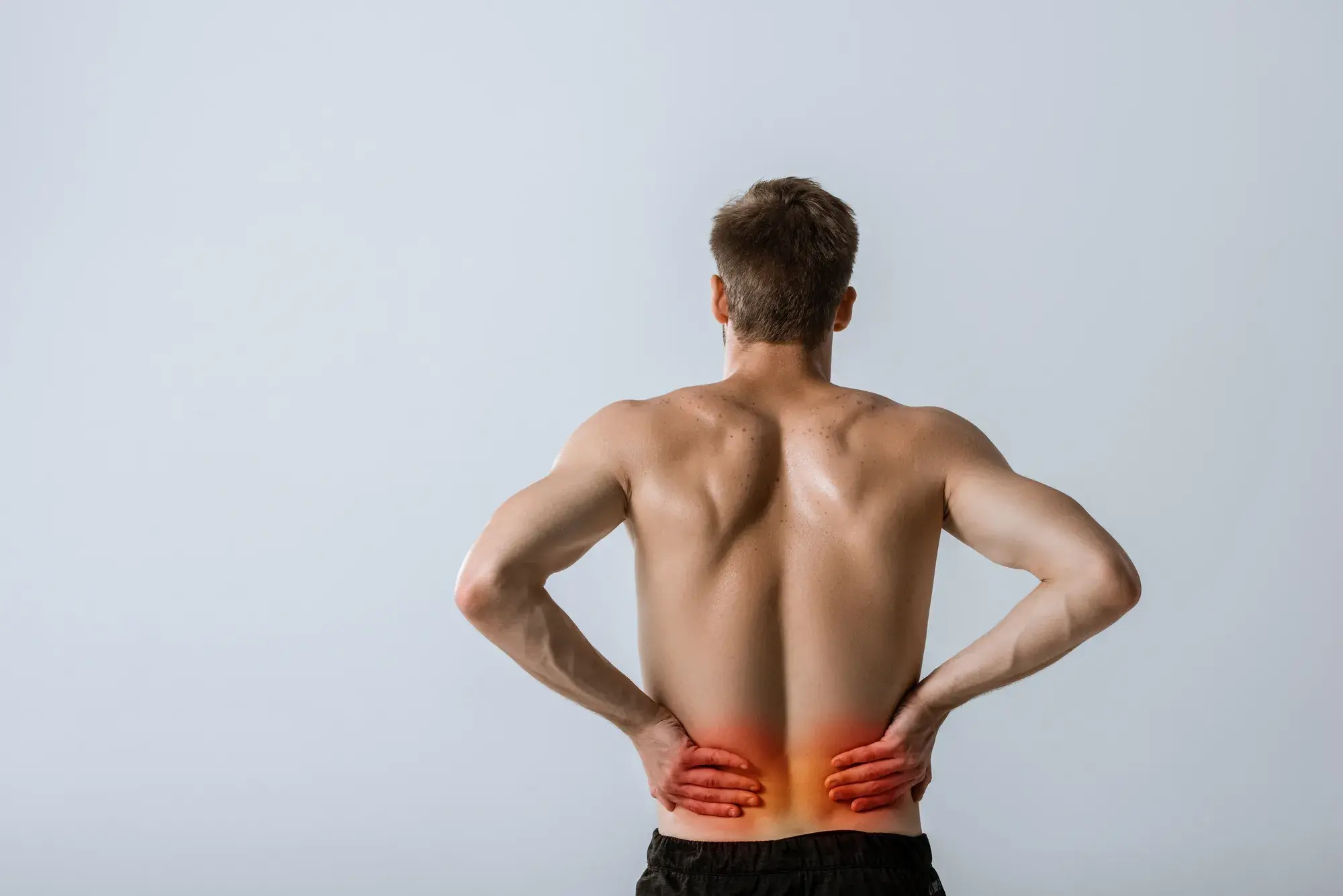
How To Tell If Back Pain Is Muscle Or Disc
Read More
July 24, 2023
Low back pain is a severe musculoskeletal issue that affects nearly a quarter of the population, causing professionals to lose up to 10% of their work time each year. Besides long-lasting pain, reduced mobility, and distress, low back pain also impacts other aspects of a person’s life, starting with sleep health.
Studies estimate that nearly 60% of people with low back pain also experience disrupted sleep and low sleep quality. In turn, sleep disturbances can lead to a cascade of profoundly-impacting consequences like chronic fatigue, stress and irritability, low productivity, and more intense pain.
Fortunately, there is no need to surrender to living with back pain or take pain medications daily. With Neurofunctional Pain Management – the whole-person approach pioneered by Relatyv – you can live free of low back pain, restore your sleep quality, and lay the foundations of long-term musculoskeletal health. Learn all you need to know below.
According to 2023 statistics, over 23% of adults suffer from back pain, but other studies suggest that the lifetime prevalence of this condition might be as high as 84% in the adult population.
While this musculoskeletal condition is certainly widespread, it remains challenging to diagnose and treat – and there’s more than one reason for this. Firstly, back pain can be either “primary” – if it is, in itself, the condition – or “secondary” – if it is a symptom of another underlying condition like pancreatitis, endometriosis, or renal colic.
Additionally, the causes of low back pain are often difficult to pinpoint. Currently, up to 85% of cases of low back pain are classified as “non-specific”, which means that there is no inflammation, structural problem, or disease causing the pain.
To make things even more complicated is the fact that the symptoms of low back pain may vary in nature and intensity from one person to another. Some patients experience shooting pain that from the low back runs through their buttocks and legs, while others experience life-limiting dull aches for months at a time.
To simplify the process of obtaining a diagnosis and finding the right line of treatment, depending on your symptoms, your healthcare provider may classify your back pain as axial or radicular. Let’s look at these conditions below.
Axial back pain refers to a type of back pain that is concentrated in a single painful area, usually in the lumbar (lower) spine. Axial low back pain is the most common type of low back pain and is often non-specific, meaning that there is no injury or disease at its root cause.
Nonetheless, this type of low back pain is often structural or mechanical, it tends to be associated with the degeneration of the components of the spine, and it does not usually involve inflammation. Although it can resolve on its own within a few days to a few weeks, this musculoskeletal condition can significantly impact a person’s life.
Axial back pain can either be acute or chronic:
Radicular low back pain is a type of pain that originates in the lower back, travels through along the spine, and radiates to the hip, buttocks, and legs. Radicular back pain is often associated with injury to the nerves that radiate from the spinal nerve root.
When one or more of these nerves are compressed or irritated, the normal transmission of sensory and motor signals to and from the brain is disrupted. This results in other symptoms like burning sensations, numbness, muscle weakness, and tingling.
In some cases, this type of pain resolves itself within six weeks, but it can also be recurring or chronic. Two of the most common causes of radicular back pain include:
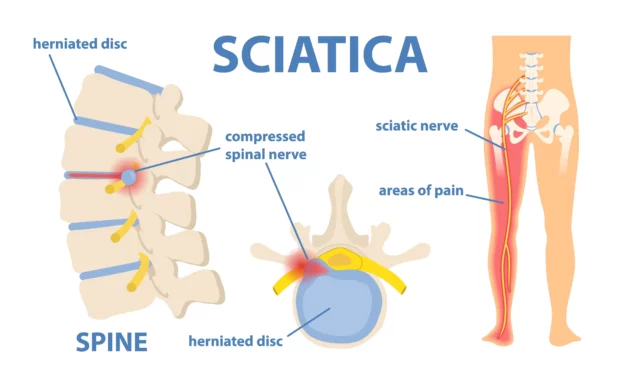
As seen above, low back pain can appear in many forms – all of which can be equally disrupting to your daily life. In particular, chronic and acute back pain can prevent you from getting the quality sleep you need to be energized and productive during the daytime.
According to a 2015 study, low back pain is strongly associated with both short sleep duration and poor sleep quality. The reasons for these are many:
It is also important to consider that certain risk factors for low back pain – such as excessive consumption of alcohol and a sedentary lifestyle – can also worsen sleep quality.
Suffering from low back pain and experiencing poor sleep quality can create a vicious circle. As studies have shown by a 2014 study, experiencing poor sleep quality at night caused by back pain is often followed by a day of higher pain intensity, which can make it even more difficult to get good-quality sleep the night after.
So, not only poor sleep quality and back pain are connected by a two-way relationship, but they are also mutually reinforcing. While this is nothing more than a temporary problem for those people suffering from occasional aches, patients with chronic back pain can see their lives profoundly disrupted by these dynamics.
Some ways in which poor sleep affects pain include:
Lastly, it is important to highlight the relationship between a lack of sleep and the prevalence of mental health disorders. Anxiety, depression, and high levels of stress can impact your physical health and worsen your chronic pain.
While targeting the root cause of your back pain is essential to find a permanent remedy to this condition, there is a lot that you can do to improve your sleep quality and ease your back pain – starting with finding the best sleeping position for your lower back.
Given the fact that we spend 7-9 lying in bed, the way we position ourselves during sleep plays a major role in determining how forces are distributed across the spine and how the vertebrae align when lying down. Through the correct alignment of the spine, it is possible to ease the pressure on the lower back to alleviate pain and improve overall spine health.
Generally, any sleep position that involves the twisting or contorting of the spine will put pressure on certain vertebrae and should be avoided. So, you should find a comfortable position that allows you to keep the spine aligned and the weight equally distributed across its length.
While investing in a high-quality mattress and pillows is certainly the first step to getting a better night’s sleep, positioning yourself correctly before falling asleep can help. Let’s look at the benefits of these positions below.
One of the healthiest ways to sleep is on your back, using a pillow positioned under your lumbar spine to promote natural spine alignment. This position will help your head, neck, and hips remain in a neutral position throughout the night, thus relieving pressure points on the lumbar spine.
For additional support, it is recommended to place a pillow under the neck and a small, rolled towel under the lower curve of the spine. This position is recommended if you are a back sleeper naturally.
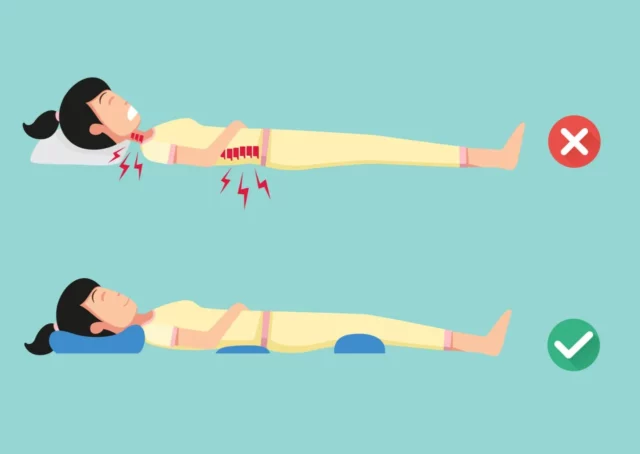
Another excellent option to relieve your back pain is to sleep on your side with your knees partially bent. This position keeps the spine neutral and naturally aligned, but it also alleviates the pressure on the cartilage discs between the spines, allowing them to regain hydration and thickness during the night. As they swell, they can reduce the pressure on the other components of the spinal column, including bones, joints, and the nerves in the spinal cord.
While this sleeping position is generally considered beneficial for back pain, it is essential to follow a few key steps:
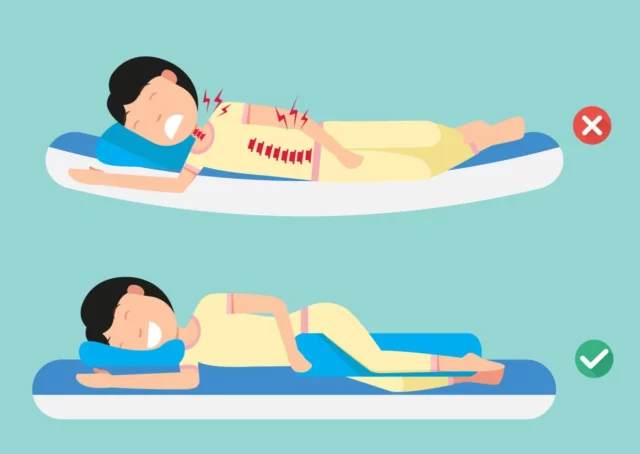
If the low back pain is caused by herniated discs, you may also benefit from sleeping in a fetal position. Drawing your legs closer toward your torso can stretch out the spine, allowing the discs to plump up and reduce the pressure on the spinal cord.
If you prefer to sleep on your back, you can do so in a reclined position. Investing in an adjustable bed or arranging your pillows to create a gentle slope can help you maintain a comfortable position throughout the night.
Reclining is beneficial in that it reduces the pressure on the lower back and creates an angle between the higher and lower parts of the body at the hips. This angle can reduce the pressure that occurs when laying flat on your back, particularly if you suffer from spondylolisthesis.
This condition occurs when a vertebra slips over an adjacent one, usually in the lower spine. It causes pain and spine instability and can lead to chronic low back disorders.
If you tend to change position often, or you prefer to sleep on your back without pillows under the spine, you may consider laying flat on your back and placing a pillow (or rolled-up towel) underneath your knees instead.
Not only does this position feel natural to most sleepers, but it also ensures the correct alignment of the spine. The pillow under the knees has the function of keeping a neutral curvature in the lower back, preventing it from sagging into the mattress.
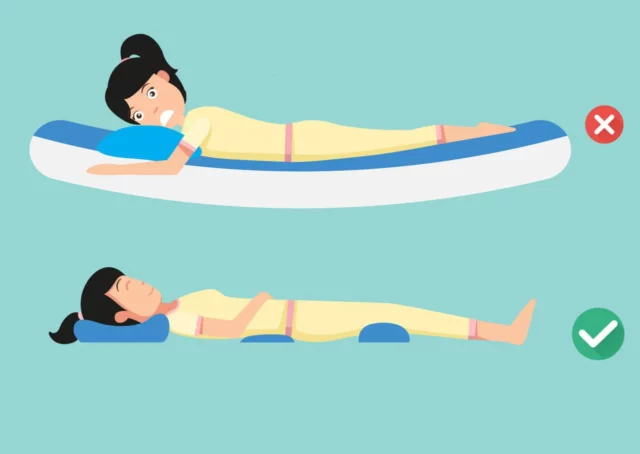
Some sleeping positions can be counteractive for your spine health and even intensify your lower back pain. This is especially true for back and stomach sleepers who don’t use props such as pillows, rolled-up towels, and reclining mattresses.
Below, we’ll look at some of the sleeping positions that, by adding pressure to the spine, can aggravate your low back pain and its complications.
Sleeping on your stomach can cause the spine to bend backward and put pressure on certain areas, such as the neck and lumbar spine. What’s more, since you’ll need to twist your head to breathe when lying prone, you’ll also be contorting the spine and affecting its natural alignment.
Nonetheless, if you tend to sleep on your stomach and you are struggling to break the habit, there are easy ways to reduce the strain on your lower back. These include:
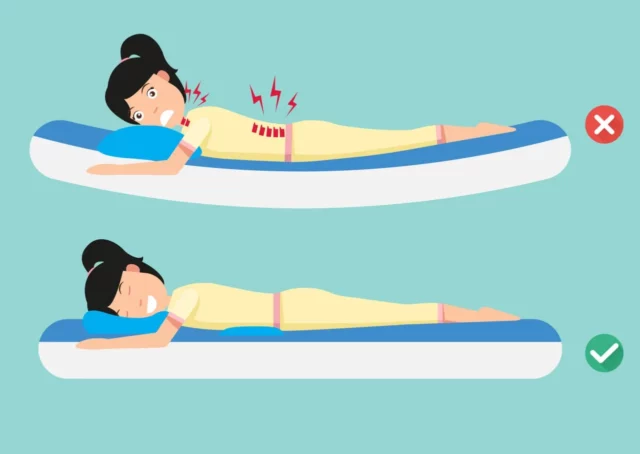
If you suffer from degenerative disc disease, sleeping on your stomach with the necessary props can actually be beneficial. Indeed, this position removes most external pressures from the intervertebral discs, which are allowed to swell and re-expand, thus getting back into position away from the nerves in the spinal cord.
As seen above, sleeping on your back without the necessary tools can cause multiple misalignments in the spine. To prevent this habit from exacerbating your back pain, correct your sleeping position with pillows under the knees, legs, and lower back. This simple solution will help you support the natural curve of the spine and maintain a neutral position while you sleep.

Sleeping in a position that eases the pressure on your low back and contributes to maintaining proper spine alignment is a great strategy to improve your sleep quality. However, this isn’t the only factor to influence your overall spine and sleep health.
Below, we’ll look at some easy-to-adopt sleep solutions that can ease your back pain.
Your choice of mattress will play a significant role in your sleep quality and low back pain intensity. With the wrong mattress, you may not even be able to adjust your sleeping position to promote proper spine alignment.
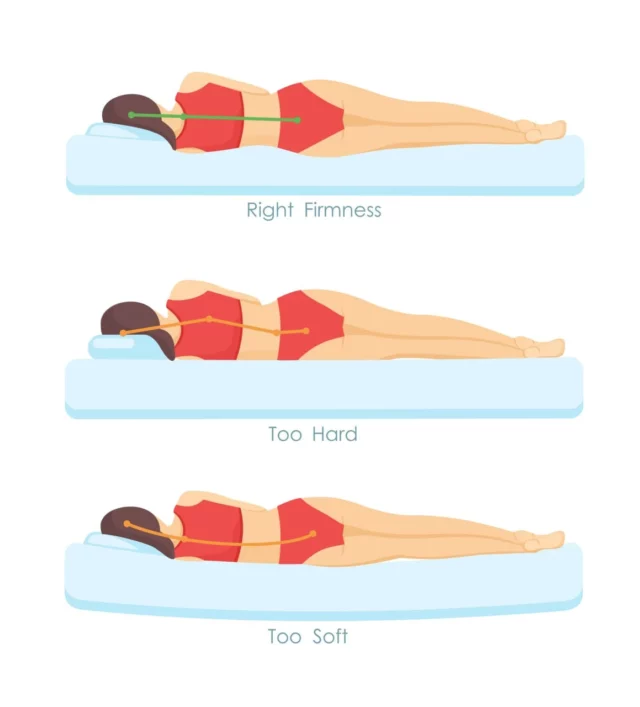
That is why, to ease back pain and promote health, you should consider upgrading to a mattress that is medium-firm, offers lumbar support, and is designed with hypoallergenic materials. The level of firmness should be adjusted to your weight and preferred sleeping position.
In terms of pillows, opt for ergonomically-designed and supportive models, but be sure to choose a thickness that does not cause your spine to sag or bend abnormally.
Studies have confirmed that there is a two-way connection between physical activity and sleep quality. Sleeping 7-9 hours each night can help you replenish your energy, boost your physical performance, support your mental health, and help you stay motivated to exercise daily.
On the other hand, leading an active lifestyle and partaking in physical activity regularly can offer many benefits for your sleep quality and spine health:
Ultimately, the study concludes that regular exercise may be an efficient nonpharmacologic therapy for adults suffering from sleep disorders.
Both alcohol and caffeine can significantly disrupt your sleep.
Caffeine is a stimulant that blocks sleep-promoting receptors in the brain, causing heightened feelings of awakeness and alertness. Even when taken 6 hours before bed, caffeine can delay falling asleep by 1 hour.
On the other hand, alcohol is a relaxant and, initially, a drink can help you doze off. However, after a few hours of sleep, alcohol can cause you to wake up and make it difficult to go back to sleep. This reduces the time you spend in the REM (Rapid Eye Movement) phase, translating into a disturbed sleep that fails to bring restfulness. Even a low amount of alcohol (1-2 drinks) will reduce your sleep quality by over 9%.
It is also important to note that alcohol and nicotine increase inflammation, which can intensify your low back pain.
Although a bedtime routine may not alleviate your low back pain alone, it can help you fall asleep faster and remain asleep for longer. In turn, as seen above, a good night’s sleep can help reduce painful sensations and make your condition more easily manageable.
When designing a bedtime routine that suits your needs, consider the following aspects:
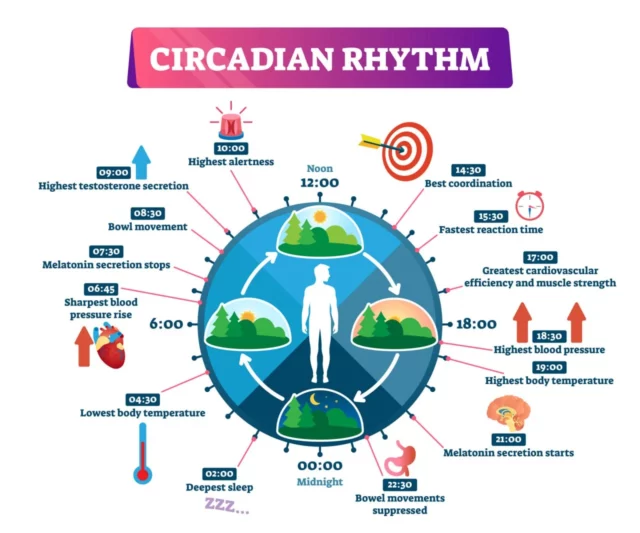
Some sleep medications can help you fall asleep faster even when you are experiencing pain. These medications include Benadryl and Unisom, which are sedating antihistamines. Alternatively, you may try natural alternatives like melatonin supplements and teas infused with plants that have relaxing properties (i.e.: valerian).
However, it is important to note that sleep aids may not work equally well for every person, and they are not free of side effects. Most sleep medications and supplements can cause drowsiness, daytime sleepiness, urinary incontinence, headache, nausea, and constipation. Because of the risk involved with this line of treatment, you should only consider taking sleep aids during low back pain flare-ups and under the supervision of a specialist.
Finding the right sleeping position for your needs remains one of the most important strategies to improve your sleep quality and ease your low back pain. Test the positions seen above to find the best one for your needs and don’t be afraid to experiment with pillows, rolled-up towels, and other support tools.
Although low back pain is certainly life-altering, in most cases, it resolves on its own with the help of at-home remedies. However, in some cases, low back pain can be a sign of an underlying disease, a degenerative condition of the spine, or severe mechanical problems. Because of this, it is crucial to understand when you should see a doctor.
Generally, you should get in contact with your healthcare provider if your low back pain isn’t going away or getting better. It is also recommended to see a doctor if your poor sleep quality begins to interfere with your ability to live your life normally.
Other signs and symptoms associated with back pain that should not be overlooked include:
You should also seek an accurate diagnosis if you have a personal history of cancer.
There is no doubt that low back pain can significantly disrupt all aspects of your life – starting with your sleep quality. However, taking pain medications or relying on sleeping aids to secure a few hours of sleep each night are no longer the only options!
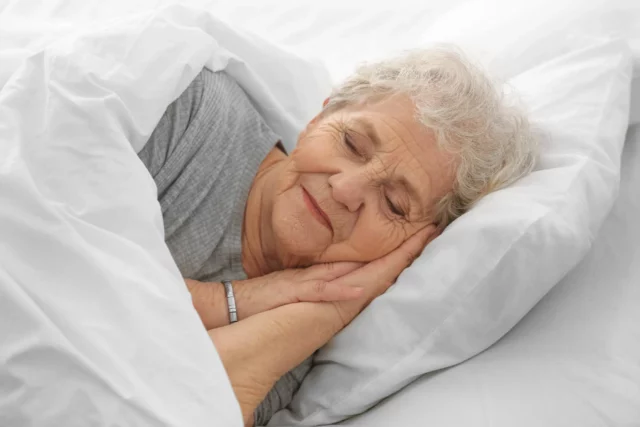
With the whole-person approach pioneered by Relatyv, you can regain your sleep quality and live free of back pain without medications or invasive procedures.
Neurofunctional Pain Management uses non-drug and non-surgical treatments like electroanalgesia, IV therapy, and lifestyle counseling to address your back pain, restore your sleep quality, and lay the basis for long-lasting musculoskeletal health.
About the Author
Will is a healthcare executive, innovator, entrepreneur, inventor, and writer with a wide range of experience in the medical field. Will has multiple degrees in a wide range of subjects that give depth to his capability as an entrepreneur and capacity to operate as an innovative healthcare executive.
Share on Social Media




You can see how this popup was set up in our step-by-step guide: https://wppopupmaker.com/guides/auto-opening-announcement-popups/
You can see how this popup was set up in our step-by-step guide: https://wppopupmaker.com/guides/auto-opening-announcement-popups/
Neurofunctional Pain Management Overview
Symptoms
Conditions Treated
Treatments
Articles by Category
Locations
Colorado
Wisconsin
Georgia
Hiram
Lawrenceville
Marietta
Powder Springs
Texas
Waco
Victoria
Illinois
Buffalo Grove
New Lenox
St. Charles
Arizona
Tucson
Waddell
Arlington
Avondale
Buckeye
Superior
Mesa
Palo Verde
Morristown
Tempe
Chandler
Anthem
Eloy
Florence
Fort McDowell
Phoenix
El Mirage
Coolidge
Gilbert
Arizona City
Casa Grande
Casa Blanca
Aguila
Sacaton
Apache Junction
Kearny
Stanfield
Goodyear
Litchfield Park
Alabama
Arkansas
California
Florida
Idaho
Indiana
Iowa
Kansas
Louisiana
Maryland
Michigan
Rhode Island
Minnesota
Mississippi
Nevada
New Jersey
New Mexico
North Carolina
Ohio
Pennsylvania
South Dakota
Tennessee
Utah
Virginia
Washington

